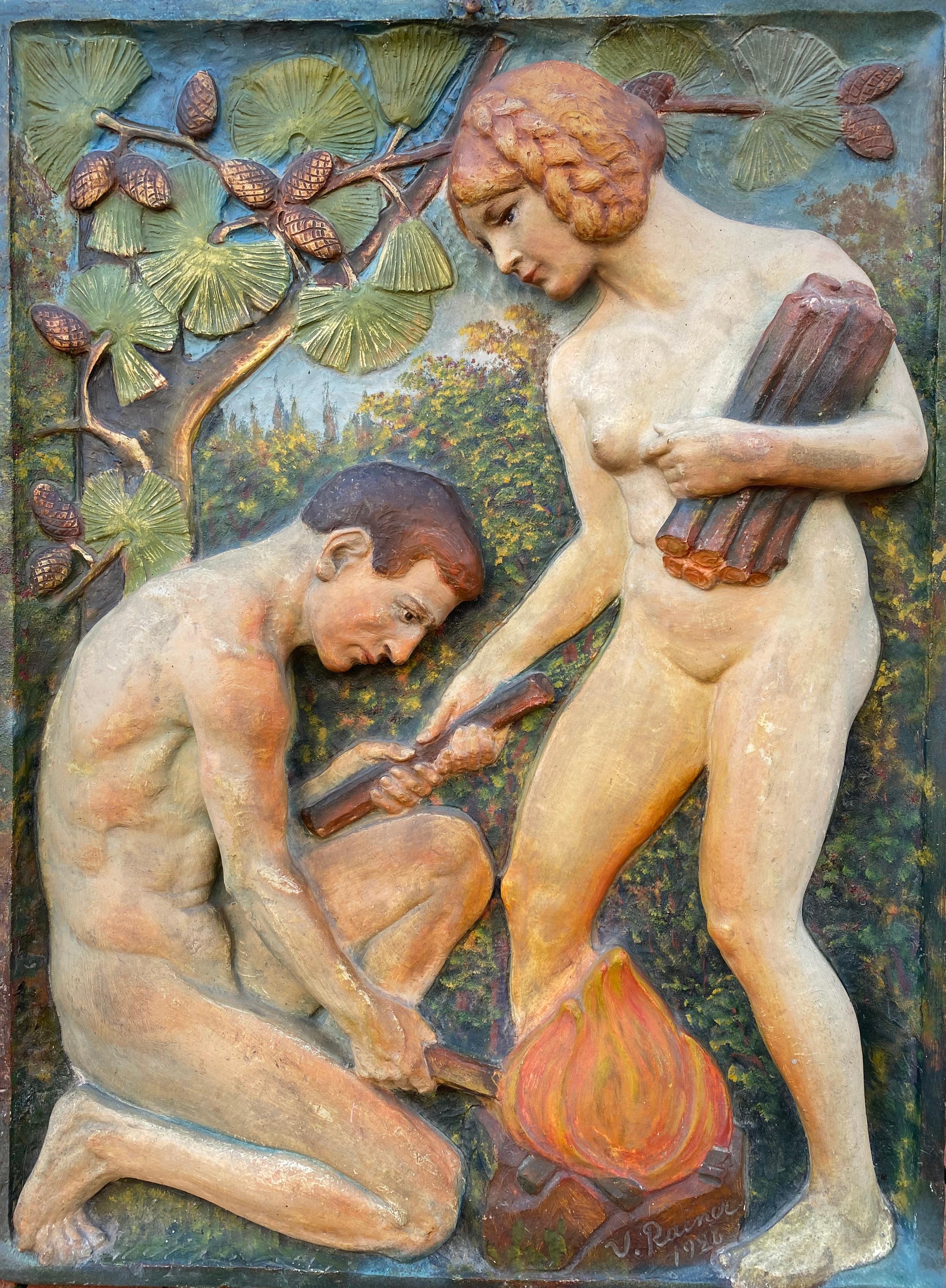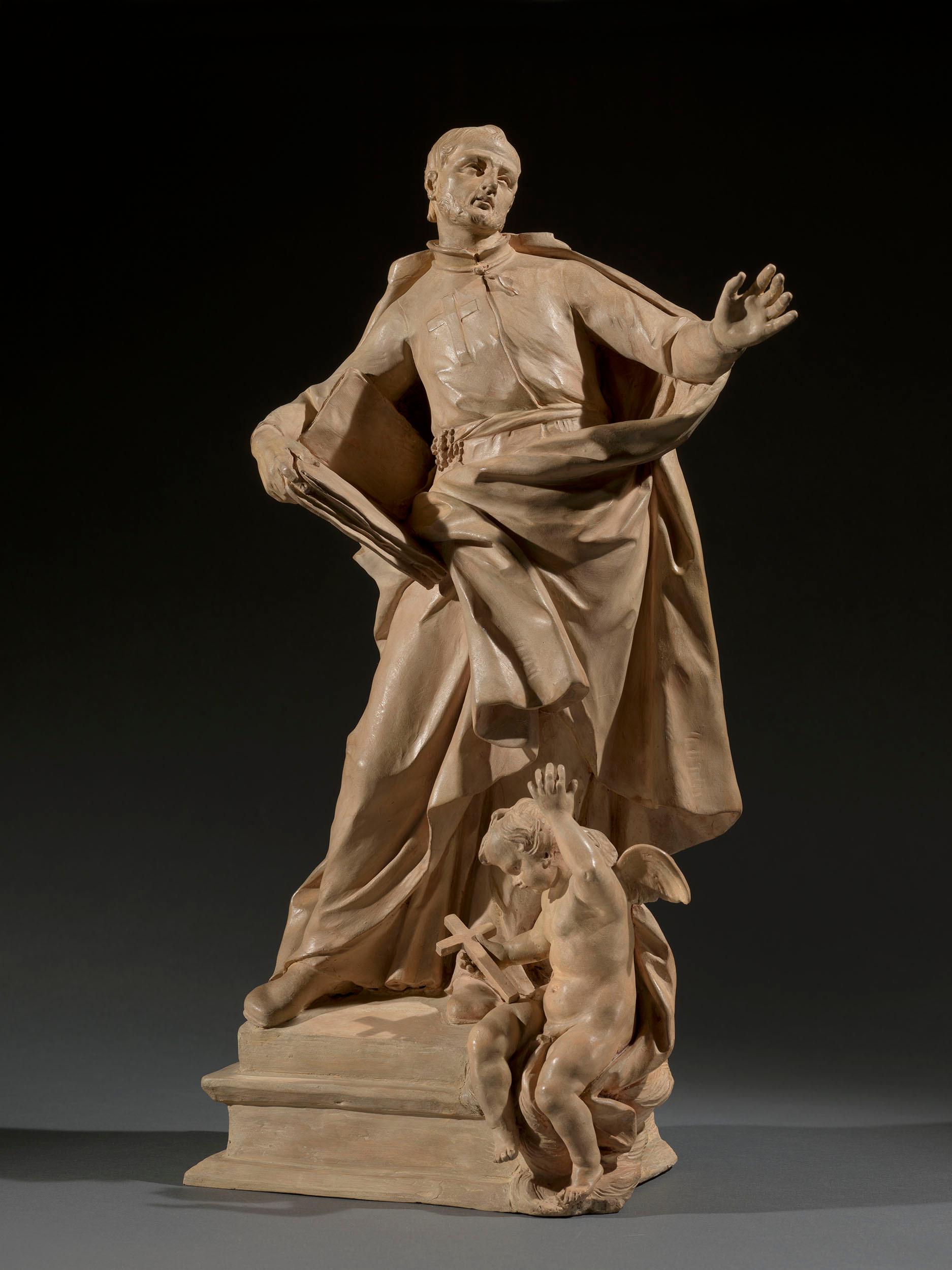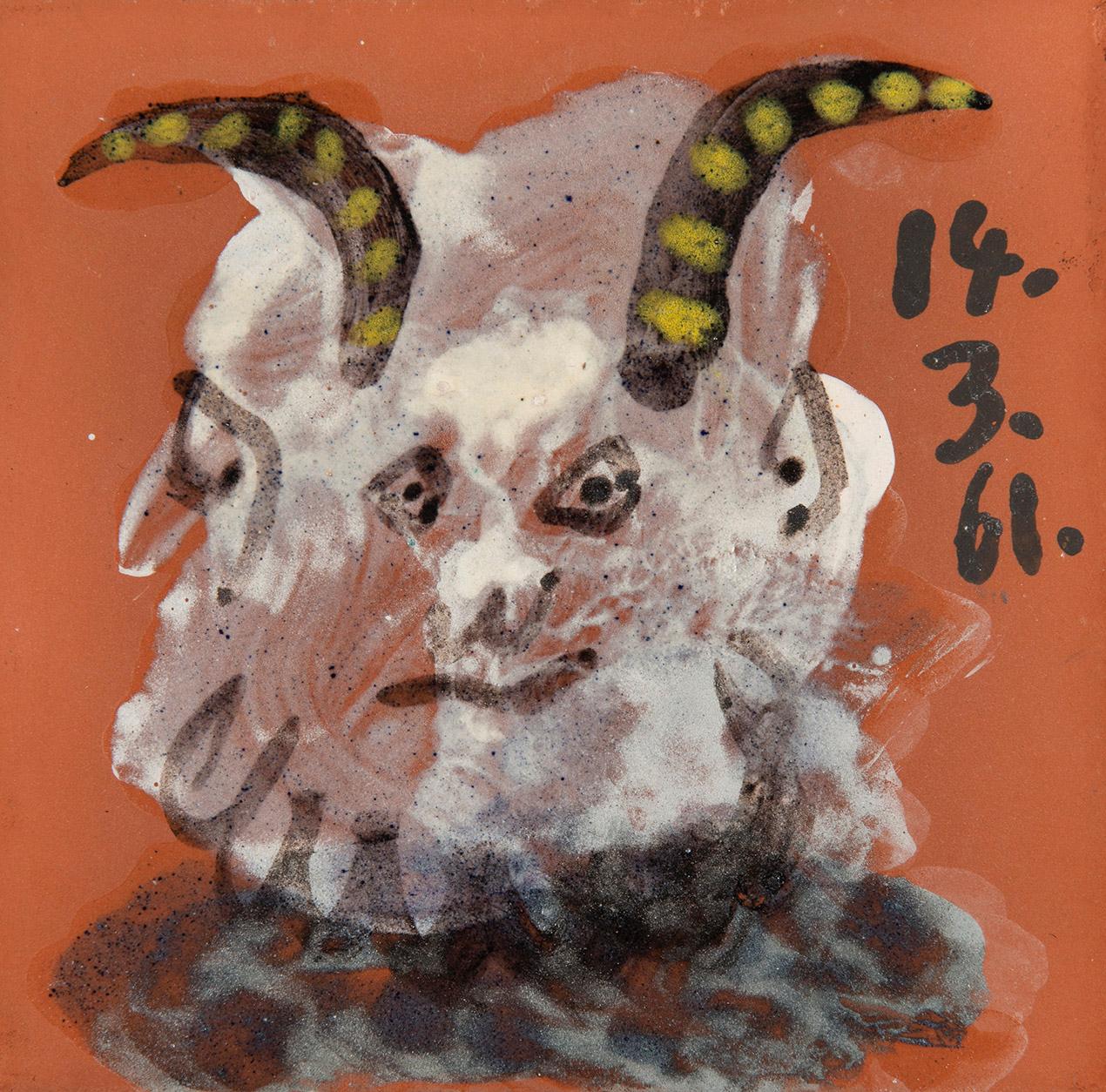Items Similar to Porteur D'eau by Joseph Guluche
Want more images or videos?
Request additional images or videos from the seller
Joseph Le GuluchePorteur D'eau by Joseph Guluche1885
1885
About the Item
A 19th century terracotta statue of a North African carrying water by Joseph Le Guluche.
The subjects of Joseph Le Guluche have a great presence, always very expressive, often in movement and they are carved exquisitely by their author.
His works are very detailed, of a high standard and are now becoming rare for collectors to find. This statue is in its natural state never been restored but showing just slight wear in accordance with its age.
This work is signed on the terrace "PORTEUR D"EAU par J Guluche" with an Edition stamp
- Creator:Joseph Le Guluche (1849 - 1915, French)
- Creation Year:1885
- Dimensions:Height: 20.87 in (53 cm)Width: 5.91 in (15 cm)Depth: 6.7 in (17 cm)
- Medium:
- Period:
- Condition:
- Gallery Location:LA BOUILLE, FR
- Reference Number:1stDibs: LU1808210073612
About the Seller
No Reviews Yet
Vetted Seller
These experienced sellers undergo a comprehensive evaluation by our team of in-house experts.
Established in 1998
1stDibs seller since 2022
- ShippingRetrieving quote...Ships From: ROUEN, France
- Return PolicyA return for this item may be initiated within 3 days of delivery.
More From This SellerView All
- Pair of Terracotta Nubiens probably GoldsheiderLocated in LA BOUILLE, FRAn exquisite set of a pair of North African orientalist/africanist terracotta sculptures of a man and female conveying water containers. Most likely by Goldsheider, incredibly molded...Category
Late 19th Century Still-life Sculptures
MaterialsTerracotta
- The Great Fire of Rome AD64Located in LA BOUILLE, FRAn amazing 19th century view of Capitoline Hill Rome before and during the Great Fire of Rome AD64 destroying 2 thirds of the city. This is a rare a...Category
1880s French School Landscape Drawings and Watercolors
MaterialsWatercolor
- "Maternity" by Jose Royo 20th century oil on Board SignedBy José RoyoLocated in LA BOUILLE, FR"The Maternity" by Jose Royo oil on board. Oil on board Jose Royo's "The Maternity." Even in its small frame, this powerful painting packs a big punch becau...Category
Late 20th Century Modern Portrait Paintings
MaterialsOil, Board
- Wonderful Portrait of exceptional qualityLocated in LA BOUILLE, FRLouis Felix Amiel 1802-1864. Ecole national superieure des Beaux Arts. This painting signed bottom left is of exceptional quality resembles the playwright Charles Theodore Cogniard t...Category
Mid-19th Century French School Portrait Paintings
MaterialsCanvas, Oil
- Diana Bathing 18th Century Oil on Canvas by Friedrich Olenhanz 1765-1839Located in LA BOUILLE, FR"As the incarnate of dawn shines in the morning, such a blushed Diane's complexion exposed without veils to the eyes of a mortal" Les Métamorphoses by Ovide Less tragic is our destin...Category
18th Century French School Paintings
MaterialsCanvas, Oil
- A portrait of a young man 19th century oil on canvasLocated in LA BOUILLE, FRCharles Gustave, Baron Wappers (23 August 1803 in Antwerp - 6 December 1874 in Paris) was a Belgian painter, also known by his Flemish name, under which he signed his works, Egidius Karel Gustaaf or Gustaf Wappers. He was introduced to the art of painting at the academy of painting in Antwerp where he was a student of Guillaume Herreyns and Mathieu-Ignace van Brée, his trip to Paris in 1826 allowed him to introduce the Romantic movement, then essentially French, into the future kingdom of Belgium. He was successively made commander of the orders of Leopold and Christ (in Portugal), Grand Cross...Category
Mid-19th Century French School Portrait Paintings
MaterialsCanvas, Oil
You May Also Like
- The TrapdoorBy Arturo MartiniLocated in Roma, RMArturo Martini (Treviso 1889 - Milan 1947), La Botola (1930 / 1933) Terracotta sculpture 34 x 42 x 9 cm signed lower left; label of Galleria del Milione, Milan, on back. Provenance...Category
1930s Italian School Figurative Sculptures
MaterialsTerracotta
- “Adam and Eve”Located in Southampton, NYVery rare Art Deco three dimensional terracotta sculpture of Adam and Eve by the Austrian artist, Virgil Rainer. Hand painted by the artist. Signed bott...Category
1920s Art Deco Figurative Sculptures
MaterialsTerracotta, Plaster
- Roman 18th century terracotta model for the sculpture of San Camillo de LellisLocated in London, GBThis remarkably fluid terracotta bozetto was made in preparation for Pietro Pacilli’s most important public commission, a large-scale marble statue of San Camillo de Lellis for the nave of St Peter’s Basilica in Rome. Expressively modelled, this terracotta sculpture is a rare and significant work made by a major Roman sculptor at a transformative moment of European sculpture. Pacilli began his working life on the great Baroque decorative projects initiated in the seventeenth century, but he found success as a restorer of ancient sculpture working to finish antiquities for a tourist market, becoming an important figure in the emergence of an archaeologically minded Neoclassicism. Pacilli trained Vincenzo Pacetti and provided important decorative work for the Museo Pio-Clementino, at the same time he is recorded restoring some of the most celebrated antiquities excavated and exported during the period. Pacilli was born into a family of Roman craftsmen, his father Carlo was a wood carver, and Pacilli is recorded working with him on the Corsini Chapel in San Giovanni Laternao as early as 1735. In 1738 his terracotta model of Joseph and Potiphar’s Wife won the first prize in the second class of the sculpture concorso at the Accademia di San Luca, this is particularly notable as Bartolomeo Cavaceppi came third. He worked as a carver and stuccoist completing works for the churches of San Marco and SS. Trinita dei Domeniciani Spagnoli. Pacilli operated as a sculptor and restorer of antiquities from his studio at the top of the Spanish Steps, close to Santa Trinita dei Monti, where he is listed as a potential vendor to the Museo Pio-Clementino in 1770. In 1763 Pacilli completed a silver figure of San Venanzio for the treasury of San Venanzio. He is recorded as Pacetti’s first master and it was evidently through Pacilli that he began to acquire his facility as a restorer of ancient sculpture. Pacilli, at his studio ‘poco prima dell’Arco della Regina alla Trinita dei Monti,’ exercised, what the nineteenth-century scholar, Adolf Michaelis called ‘rejuvenating arts’ on several important pieces of classical sculpture, including in 1760 the group of a Satyr with a Flute for the natural brother of George III, General Wallmoden, Hanovarian minister at Vienna. In 1765, Dallaway and Michaelis record that Pacilli was responsible for the restorations, including the addition of a new head, to the Barberini Venus which he had acquired from Gavin Hamilton. The Venus was then sold to Thomas Jenkins, who in turn passed it on to William Weddell at Newby Hall. In 1767 Pacilli exported a series of ancient busts ‘al naturale’ including portraits of Antinous, Julius Ceaser and Marus Aurelius, also a statue of a Muse and a Venus. As early as 1756 Pacilli seems to have been operating as an antiquarian, helping to disperse the collection of the Villa Borrioni. Pacilli supplied sculpture to notable British collectors, including Charles Townley, who on his first trip to Italy purchased the Palazzo Giustiniani statue of Hecate from Pacilli. Pacilli was involved with the Museo Pio Clementino from its conception, supplying busts of Julius Ceaser and a Roman Woman as well as completing stucco putti surmounting the arms of Pope Bendedict XIV to signal the entrance to the new Museo Critiano. In 1750 Il Diario Ordinario del Chracas announced that Pacilli had begun work on a sculpture of San Camillo de Lellis for St Peter’s. Camillo de Lellis founded his congregation, the Camillians, with their distinctive red felt crosses stitched on black habits in 1591. Having served as a soldier in the Venetian army, Camillo de Lellis became a novitiate of the Capuchin friars, he moved to Rome and established a religious community for the purpose of caring for the sick. In 1586 Pope Sixtus V formerly recognised the Camillians and assigned them to the Church of Santa Maria Maddalena in Rome. Camillo de Lellis died in 1614 and was entombed at Santa Maria Maddalena, he was canonised by Benedict XIV on June 26, 1746. It was an occasion that prompted the Camillians to make a number of significant artistic commissions, including two canvases by Pierre Subleyras showing episodes from San Camillo’s life which they presented to Benedict XIV. In 1750 Pacilli was commissioned to fill one of the large niches on the north wall of the nave with a sculpture of San Camillo. The present terracotta bozetto presumably had two important functions, to enable Pacilli to work out his ideas for the finished sculpture and at the same time to show his design to the various commissioning bodies. In this case it would have been Cardinal Alessandro Albani and Monsignor Giovan Francesco Olivieri, the ‘economo’ or treasurer of the fabric of St Peter’s. Previously unrecorded, this terracotta relates to a smaller, less finished model which has recently been identified as being Pacilli’s first idea for his statue of San Camillo. Preserved in Palazzo Venezia, in Rome, the terracotta shows San Camillo with his left hand clutching his vestments to his breast; the pose and action more deliberate and contained than the finished sculpture. In producing the present terracotta Pacilli has expanded and energised the figure. San Camillo is shown with his left hand extended, his head turned to the right, apparently in an attempt to look east down the nave of St Peter’s. The model shows Pacilli experimenting with San Camillo’s costume; prominently on his breast is the red cross of his order, whilst a sense of animation is injected into the figure through the billowing cloak which is pulled across the saint’s projecting right leg. The power of the restrained, axial contrapposto of bent right leg and outstretched left arm, is diminished in the final sculpture where a baroque fussiness is introduced to the drapery. What Pacilli’s terracotta demonstrates, is that he conceived the figure of San Camillo very much in line with the immediate tradition of depicting single figures in St Peter’s; the rhetorical gesture of dynamic saint, arm outstretched, book in hand, head pointed upwards was perhaps borrowed from Camillo Rusconi’s 1733 sculpture of St. Ignatius...Category
18th Century Baroque Figurative Sculptures
MaterialsTerracotta
- Medusa and AndromedaBy Magdeburger Kunstwerkstatten Reps and TrinteLocated in West Hollywood, CAMedusa and Andromeda, is a unique three dimensional terra cotta sculpture/vase, created by the German firm Magdeburger Kunstwerkstatten, Reps and Trinte, a studio that specialized in fine works in terra cotta. This monumental piece depicts the entire story of the Medusa, who holds Andromeda captive by chaining her to rocks in the ocean. You can see the chains at her wrists and ankles. Medusa charges the Leviathan (dragon) as guard over the captive Andromeda. Andromeda was rescued by her future husband Perseus who killed the dragon and saved his future bride. This is one of the most unique works of its kind that has been seen to date. It was probably a sculpture/vase designed and created for presentation at one of the yearly Salon exhibitions in Europe. We have consulted experts in European ceramics...Category
Early 1900s Figurative Sculptures
MaterialsTerracotta
- Tête de Faune, Picasso, Unique work, 1960's, Terracotta, Tiles, Design, SculpturBy Pablo PicassoLocated in Geneva, CHTête de Faune, Picasso, Unique work, 1960's, Terracotta, Tiles, Design, Sculptur Tête de faune Unique work 14.03.1961 Painted and glazed terracotta tile...Category
1960s Post-War Figurative Sculptures
MaterialsTerracotta
- Tête de Faune, Pablo Picasso, Unique piece, Design, Terracotta, Tile, MythologyBy Pablo PicassoLocated in Geneva, CHTête de Faune, Pablo Picasso, Unique piece, Design, Terracotta, Tile, Mythology Tête de faune Unique work 08.08.1956 Painted and glazed terracotta tile...Category
1950s Post-War Figurative Sculptures
MaterialsCeramic, Earthenware, Terracotta
Recently Viewed
View AllMore Ways To Browse
On The Terrace
Antique Stamp Collectors
State Statue
African Statue
African Statues
Africa Statue
African Carved Art 19th Century
African Terracotta
Antique African Statue
Antique African Statues
Contemporary Body Bronze Sculptures
Australia Bronze
Girl With Bronze
Bull Gold
South Africa Sculpture
Vinyl Toy
Set Of Sculptures Pop Art
Bronze African Art





